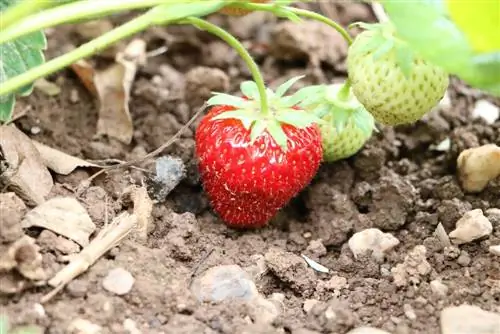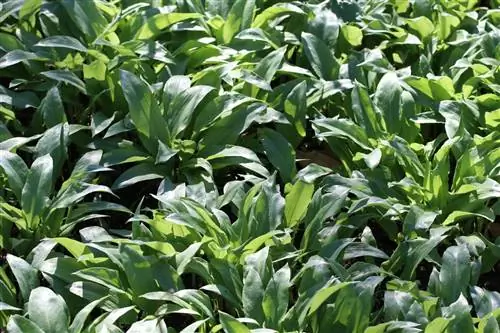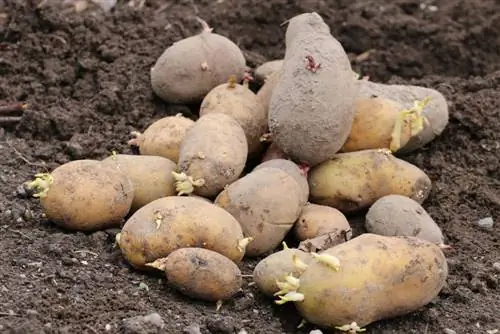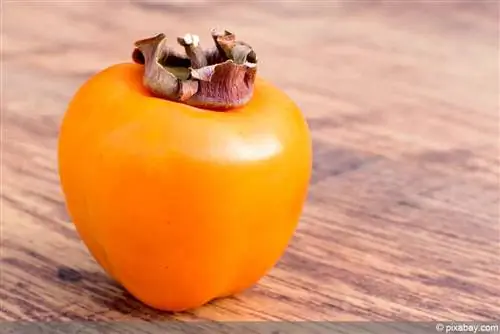- Author admin [email protected].
- Public 2023-12-17 03:39.
- Last modified 2025-06-01 06:48.
Where picturesque blossoms, decorative leaves and bright red fruits captivate the viewer on the balcony, strawberries take center stage in the flower box. In fact, the alluring fruit plants are not limited to growing in beds. These instructions will familiarize you with all the measures you need to take to transform your balcony into a strawberry paradise. From the right location to the perfect balcony box to professional care, you will find out all the important details. A hand-picked list of ideal varieties will show you the way to your personal strawberry snack garden on the balcony.
Growing instructions
The successful cultivation of strawberries in flowers is based on an interaction of important individual factors. Therefore, please pay attention to all sections of these instructions, because sometimes there are only small problems when the hoped-for harvest does not materialize.
propagation by sowing
Instead of purchasing ready-made strawberry plants, the ambitious home gardener begins cultivation right from the start. Specialist retailers have certified seeds available. Alternatively, harvest the fine seeds yourself. To do this, dry fully ripe fruits and collect the seed nutlets from the outer skin. Until the sowing date in February or March, keep the seeds dark, cool and dry. How to grow strawberries for your flower box yourself:
- Soak seeds in chamomile tea or lukewarm water for 4 to 6 hours
- Fill a seed tray with potting soil and spray with soft water
- Spread the seeds, press them down with a board and sift them thinly
- Cover the seed container with a transparent lid or cling film
Germination takes between 2 and 6 weeks in a partially shaded window seat at an ideal temperature of 16 to 20 degrees Celsius. If the substrate dries, spray it with room temperature water. At the 5-leaf stage you can transplant the seedlings into individual pots. Until the planting season begins, care is limited to regular watering in dry conditions.
Tips for the perfect flower box
For vital growth and a rich harvest, strawberries in the flower box need a sufficient substrate volume. As a rule of thumb, it has proven useful in practice to provide each plant with 25 to 30 cubic centimeters of soil. Therefore, choose flower boxes that are 25 to 30 cm wide. The length can be adjusted to the space available on the balcony. Every garden center is well stocked with 60, 90 or 120 cm long balcony boxes.
When purchasing, please make sure that a flower box has several openings in the bottom so that excess rain and irrigation water can drain away. Rounded edges prevent the tendrils of your strawberry plants from breaking. Plant boxes with an integrated irrigation system are an advantage. There is a water supply in a separate level that your thirsty plants can use. You can see when the supply needs to be refilled by looking at the water level indicator.
Tip:
Balcony boxes in dark colors attract the sun, whereupon the substrate with the root balls can heat up significantly in midsummer. The better choice is therefore plant boxes in white or light pastel colors because the sun's rays are reflected here.
Substrate - mixing it yourself is the key

Growing your own strawberries in a flower box not least offers the advantage that you will later know exactly what the fruits contain and what they do not contain. Pre-fertilized potting soil from a discount store destroys this privilege. By mixing your own potting soil for your strawberries, you pave the way to a premium quality strawberry harvest. This is how it works:
- Use organic vegetable soil without peat as a base
- Mix mature, sifted compost into the organic substrate in a ratio of 1: 3
- Add about 100 grams of horn shavings per flower box
- A few handfuls of perlite, expanded clay or lava granules for optimized permeability
If you don't have your own compost heap, you can find ready-packaged products in stores. Alternatively, add an organic long-term fertilizer for berry plants to the substrate, such as the innovative organic fertilizer with sheep's wool from Compo. The nutrients stimulate growth and flowering right from the start. A one-time addition is usually sufficient for the entire season.
Plants
The professional planting technique is based on important aspects such as the correct planting depth, appropriate planting distance and the prevention of water stagnation in the substrate. When the first warm rays of sunshine beckon at the beginning of April, the planting time for strawberries on the balcony begins. How to do it correctly:
- Place the still potted plants in water to soak the root ball
- Spread a layer of expanded clay, gravel or pottery shards on the bottom of the box as drainage
- Place a breathable fleece over it so that the water-bearing layer does not become muddy
- Fill the substrate so that a pouring edge is exposed
- Unpot the strawberries and plant them 20 to 30 cm apart
It is important to note that you measure the planting depth so that the heart bud is just above the surface of the soil. Press the substrate firmly with both hands to ensure a good soil seal. First carry the finished planted strawberry box to its location and then water it.
Tip:
So that the loose substrate mixture can settle, it is poured into the balcony box about 2 to 3 weeks before planting. This precaution prevents the root balls of freshly planted strawberries from becoming partially exposed after a while and requiring soil to be replenished.
Location

A sunny, warm and airy location in a south-facing location gives you a top quality strawberry harvest on your balcony. The frugal plants also thrive in partially shaded places. However, the abundance of flowers and fruit often leaves something to be desired.
Watering and fertilizing
One of the key functions in care is a consistent supply of water. On hot summer days, please check early in the morning and again in the evening to see whether the soil has dried out. Let the water from the watering can run directly onto the substrate until it runs out of the bottom openings. The next time you only water when the surface of the soil has noticeably dried out. Field tests in professional strawberry cultivation have proven that the best time for watering is early in the morning between 3 and 4 a.m.
If you don't want to get up so early, take care of your strawberry plants on the balcony in good time before the sun hits the leaves directly. If you follow our recommendation for a nutritious substrate mixture, additional fertilizer applications are not necessary in the first year. Only if the leaves turn light green to yellowish and indicate a nutrient deficiency should you administer a liquid organic fertilizer for berry plants. In the following years, supply strawberry plants on the balcony with an organic plant fertilizer every 3 to 4 weeks from April to September, which you add to the irrigation water.
Mulching keeps strawberries clean and he althy
In the flower box, strawberries rarely come into contact with the substrate. Rather, the long tendrils dangle elegantly over the edge. Where there are points of contact between fruit and soil, lay a layer of straw mulch. This simple trick keeps strawberries clean and protects them from rot and mold.
Pruning after harvest
Depending on your choice of variety, the harvest extends into October. When the strawberry season on the balcony is over, cut the plants back. To do this, remove all leaves and tendrils except for the heart bud. With this pruning you eliminate accumulated inhibitors that could affect another strawberry season on the balcony.
Wintering - Tips & Tricks
Strawberry plants are hardy, so they thrive in the flower box for several years. Experience shows that they retain their vitality for at least two to three years before they are exhausted in the fourth year. Since the root balls are in a vulnerable position behind the thin walls of the balcony box, we recommend this winter protection:
- After pruning, place the flower box in a niche protected from wind and rain
- Place a wooden or Styrofoam base under it
- Wrap the container with bubble wrap
- Put a coconut mat over the foil so that it extends 10 cm beyond the edge of the box
- Cover the substrate with leaves, wood wool or straw
If winter damage occurs to strawberries in the flower box, drought stress is the most common cause. Therefore, continue to water the plants so that the soil does not dry out.
Ideal varieties - a selection for the balcony

Wild strawberries and varieties derived from them are perfect for cultivation in flower boxes. In contrast to the majestic garden strawberries, they remain small and compact to give us countless, juicy, sweet fruits. A special advantage that balcony gardeners appreciate is that the following varieties fruit several times for a never-ending harvest season until autumn:
Ostara
This monthly strawberry is one of the leading varieties for growing in flower boxes. Their large, red fruits are suitable for both fresh consumption and freezing. By cleaning out the first two or three flower stalks in spring, you will increase the harvest yield. Thanks to its numerous runners, Ostara offers plenty of material for vegetative propagation every autumn.
Growth height: 30 to 40 cm
Mara de Bois
The ever-bearing strawberry variety from France impresses with medium-sized, aromatic fruits. The cone-shaped fruits with their soft flesh are ideal for snacking and making jam. Home gardeners will appreciate that this strawberry plant does not produce runners, reducing maintenance and pruning requirements.
Amandine
The new breed attracts attention with its elongated, red fruits that invite you to snack. In addition, Amandine proves to be well resistant to fungal diseases. Thanks to its soft consistency, housewives like to use this variety for cooking.
Tuscany
With beautiful, pink flowers, the strawberry plant is a feast for the eyes on the balcony. From July to October, Toscana offers fruity-sweet treats that taste best fresh from the stem. In a sunny location and cultivated according to these instructions, you can look forward to a harvest yield of up to 1 kg per plant.
Sperling’s Punch Magic
The variety name reveals that this variety is ideal for a tangy fruit pleasure. This is not contradicted by the fact that the sugar-sweet, small strawberries end up directly in the mouths of young and old or shine as a tempting cake topping. As a typical monthly strawberry, the variety blooms and fruits throughout the summer and has no annoying runners.
Mignonette
Try this alluring lover's variety for growing in the flower box. The ever-bearing wild strawberry can be enjoyed all summer long from the comfort of your deck chair. Their bushy habit and enchanting white-pink flowers also add decorative accents to the balcony.
Growth height and length: 15 to 20 cm
Forest Queen
The real wild strawberry has proven itself as a classic for growing in balcony boxes and in beds. White flowers, he althy leaves and compact growth characterize the premium variety. The small red fruits with the sugary-sweet aroma also fit in small children's mouths.
White Fairy
The creamy white fruits with yellowish nuts immediately catch the eye and harmonize wonderfully with the green leaves and white flowers. This special variety comes from the Hummi range, which conjures up strawberries with a pineapple aroma. In addition, White Fairy does not necessarily depend on a location in full sun, as it also thrives lushly and richly in partial shade.
Plena
The ideal variety for gardeners who attach more importance to decorative value than to yield. From May to July, the monthly strawberry is covered in a robe of white, lush, double flowers from which only a few fruits develop. The historic variety is known as the perfect candidate for the authentic planting plan in the cottage garden. Thanks to a growth height of 15 to 20 cm, it feels at home not only in the bed, but also in the large flower box.
Rimona
The ideal balcony strawberry from the traditional Ahrens and Siebertz company rounds off the hand-picked list of varieties. As a monthly strawberry, Rimona has everything we want from a strawberry for growing in the flower box. Compact growth, charming flowers, he althy foliage and loads of juicy, aromatic fruits from spring to autumn.
Conclusion
With these instructions, the dream of a strawberry snack garden on the balcony is within reach. A large, 25 to 30 cm wide flower box in a sunny, warm location offers the seductive plants ideal conditions for vital, productive growth. A proprietary mix of organic vegetable soil, compost and horn shavings or natural long-term fertilizer guarantees he althy strawberry enjoyment for the whole family. Care is limited to watering when it is dry, which may be necessary in the morning and evening hours in midsummer. Follow our recommendations for ideal varieties and harvest juicy, sweet fruit pralines until autumn. Pruning back to the heart bud and a thick winter coat for the balcony box ensure that strawberry plants survive the cold season unscathed.






